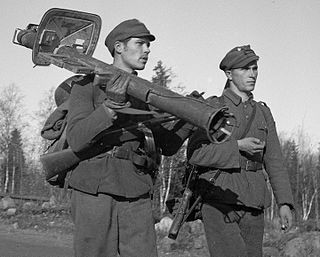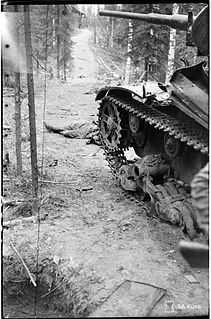
A commando is a combatant, or operative of an elite light infantry or special operations force using dedicated operation techniques.

The Utti Jaeger Regiment is the Finnish Army training and development centre for special forces and helicopter operations in charge of the Army Special Forces Unit and the Special Forces Qualification Course.

Detached Battalion 4 was a special forces unit of the Finnish Army during the Continuation War and Lapland War, serving from July 1943 to November 1944. The battalion was founded under the Intelligence Division of Defence Command from the already operational long-range reconnaissance patrol detachments created during the Interim Peace.

A long-range reconnaissance patrol, or LRRP, is a small, well-armed reconnaissance team that patrols deep in enemy-held territory.

Sissi is a Finnish term for light infantry which conducts reconnaissance, sabotage and guerrilla warfare operations behind enemy lines. The word sissi, first attested in the modern meaning "patrolman, partisan, spy" in 1787, comes to Finnish from Slavic and refers either to a forest bandit or his yew bow.

The Battle of Petsamo was fought between Finnish and Soviet troops in the area of Petsamo in the far north of Finland in 1939 and 1940. The Finnish troops were greatly outnumbered but managed to contain the Soviet troops due to the extreme terrain and weather.

The Russian commando frogmen are a Russian Naval Spetsnaz unit under operational subordination to the Main Intelligence Directorate (GRU). It is the special forces unit of the Russian Naval Infantry and is composed of highly trained and elite marines within the Naval Infantry. By virtue of belonging to the Russian Naval Infantry, frogmen fall under the Coastal Troops of the Russian Navy service arm. The Russian Navy proper does not field any special forces or special operations units. Russian FSB special forces Alpha Group and Vympel also have frogman units in their respective naval components.

The Battle of Tornio was the first major engagement between Nazi Germany and Finland in the Lapland War; although hostilities had already begun elsewhere.

The Battle of Ilomantsi was a part of the Svir–Petrozavodsk Offensive of the Continuation War (1941–1944). It was fought from July 26 to August 13, 1944, between Finland and the Soviet Union in an area roughly 40 kilometers wide and 30 kilometers deep, near the Finnish-Soviet border, close to the Finnish village of Ilomantsi, in North Karelia. The battle ended with a Finnish victory—the last major Soviet attack against Finland was stopped here.

No. 24 Squadron, renamed No. 24 Fighter Squadron was a fighter squadron of the Finnish Air Force during World War II. The squadron was part of Flying Regiment 2.

Naval Detachment K was a Finnish military detachment—specifically, a flotilla that operated on Lake Ladoga during World War II.

Detachment Kuhlmey was a temporary unit of Nazi Germany's Luftwaffe during World War II. The unit was commanded by Oberstleutnant Kurt Kuhlmey and the detachment was built around the unit Schlachtgeschwader 3, which also was commanded by Kuhlmey.
Finnish Ladoga Naval Detachment was a Finnish naval unit stationed on Lake Ladoga between 1920-1940 and 1941-1944.
The 8th Army was a field army of the Soviet Red Army during the Second World War.

The Intelligence Division of Defence Command is the unit in charge of Finnish military intelligence. Operational since the creation of the Finnish Defence Forces, its responsibility as a military intelligence service is to support the defence of Finland through information gathering and analysis with the Finnish Defence Intelligence Agency under its command.

During World War II, the Lapland War saw fighting between Finland and Nazi Germany – effectively from September to November 1944 – in Finland's northernmost region, Lapland. Though the Finns and the Germans had been fighting against the Soviet Union since 1941 during the Continuation War (1941–1944) the peace negotiations had already been conducted intermittently during 1943–1944 between Finland, the Western Allies and the USSR, but no agreement had been reached. The Moscow Armistice, signed on 19 September 1944, demanded that Finland break diplomatic ties with Germany and expel or disarm any German soldiers remaining in Finland after 15 September 1944.

Special forces and special operations forces (SOF) are military units trained to conduct special operations. NATO has defined special operations as "military activities conducted by specially designated, organized, trained, and equipped forces, manned with selected personnel, using unconventional tactics, techniques, and modes of employment".
5. Division was a Finnish Army division in the Continuation War. The division was formed by Etelä-Häme military province from the men in Kanta-Häme and Lounais-Häme civil guard districts.
The 39th Army was a Field Army of the Soviet Union's Red Army during World War II and of the Soviet Army during the Cold War.

The Seishin Operation, also called Chongjin Landing Operation, was an amphibious assault on northern Korea between August 13-17, 1945, carried out by the forces of the Soviet Northern Pacific Flotilla of the Pacific Fleet during the Soviet–Japanese War at the end of World War II.


















